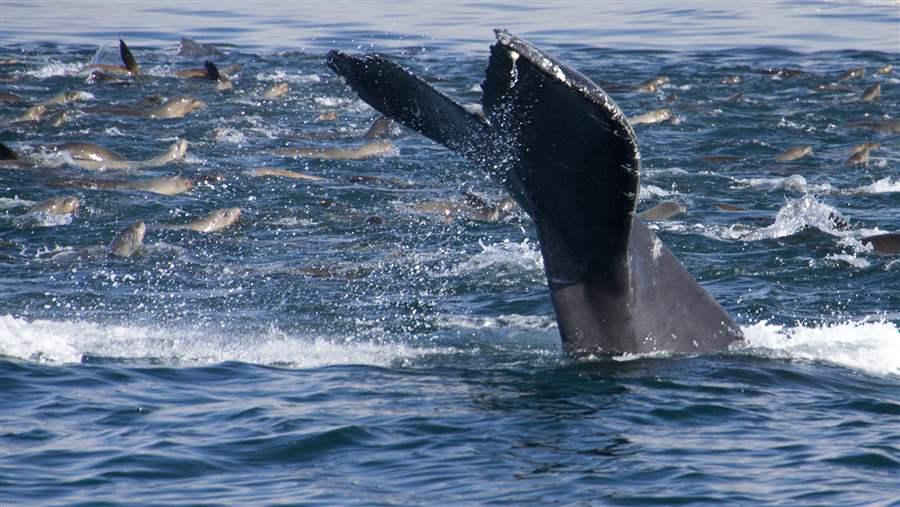More Than a Pizza Topping
Anchovies are food for ocean wildlife
 Mark Fischer
Mark FischerAnchovies are a crucial food source for a wide array of ocean wildlife on the Pacific coast, including humpback whales and sea lions drawn into California’s Monterey Bay in recent years.
Most people don’t give much thought to anchovies, unless they happen to be ordering a pizza or baiting a hook. But we know these little fish also play a big role in sustaining healthy ocean ecosystems.
Witness the scene over the past several months at California’s Monterey Bay, where people gathered to watch a feeding frenzy, with whales, seabirds, and dolphins among the Pacific Ocean predators feasting on anchovies clustered close to shore. Anchovies are a type of forage fish, a category of marine life commonly characterized by the fact that they eat microscopic plants and animals, generally form themselves into large schools, and serve as an indispensable resource—lunch—for myriad species of ocean wildlife.
Yet traditional fishery management does not explicitly account for their vital role in the ocean’s food web.
The ecological importance of forage fish highlights the need to modernize the primary law that governs fishing in U.S. ocean waters, the Magnuson-Stevens Act. The existing, conventional, single-species type of fishery management requires setting catch limits at a level that ensures enough fish are left to sustain the population so that fishing can continue in the years ahead. From an ecosystem perspective, however, it’s not enough to merely ensure that the target species can reproduce. Catch limits on forage fish must also account for their role as a food source for seabirds, mammals, and bigger fish such as salmon and tuna.
Anchovies are a case in point.
Big problems from loss of small fish
Researchers with the Farallon Institute recently compiled a large predator-prey database, which revealed that anchovies are the single most important prey species for West Coast seabirds and the most or second most important for other ocean wildlife, including humpback whales, chinook salmon, dolphins, seals, and sea lions. Unfortunately, new research also indicates that the California anchovy population has dwindled to the point of collapse, according to data collected as of 2011. The apparent further decline has come at a steep cost to the health of predators such as sea lions, as noted in recent news coverage.
The shrinking anchovy populations helped convince fishery managers to conduct a new official stock assessment for this keystone forage species.
West Coast fishery managers are among the most farsighted in the country in recognizing the ecological importance of forage fish. Last year, the Pacific Fishery Management Council unanimously agreed to prohibit new fishing of several major groups of forage fish species, unless science shows that the fishing will not adversely affect the broader marine ecosystem. Fishery managers later took the tough but necessary step of shutting down directed fishing on sardines, another critical West Coast forage fish, when the population plummeted.
But not all fishery managers are as farsighted as the Pacific Fishery Management Council.
U.S. can protect ocean ecosystems with improved federal law
As worldwide demand for forage fish continues to rise—with 90 percent of it reduced to fish meal or oil, according to the Lenfest Forage Fish Task Force—Congress needs to ensure that U.S. fishery managers establish science-based catch limits for forage fish that account for their role as a cornerstone of healthy ocean food webs.
The Magnuson-Stevens Act is approaching its 40th anniversary and could use an update. It’s time for a new focus in fishery management. Learn more here.
Paul Shively directs ocean conservation work in the Pacific for The Pew Charitable Trusts.








